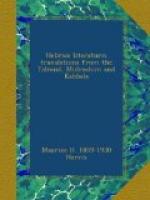Berachoth, fol. 8, col. 1.
The Sanhedrin consisted of seventy-one members. It is recorded that Rabbi Yossi said, “Seldom was there contention in Israel, but the judicial court of seventy-one sat in the Lishkath-hagazith, i.e., Paved Hall, and two (ordinary) courts of justice consisting of twenty-three, one of which sat at the entrance of the Temple-Mount, and the other at the entrance of the ante-court; and also (provincial) courts of justice, also comprising twenty-three members, which held their sessions in all the cities of Israel. When an Israelite had a question to propose, he asked it first of the court in his own city. If they understood the case, they settled the matter; but if not, they applied to the court of the next city. If the neighboring justices could not decide, they went together and laid the case in debate before the court which held its session at the entrance of the Temple-Mount. If these courts, in turn, failed to solve the problem, they appealed to the court that sat in the entrance of the ante-court, where a discussion was entered into upon the moot points of the case; if no decision could be arrived at, they all referred to the (supreme) court of seventy-one, where the matter was finally decided by the majority of votes.”
As the disciples of Shammai and Hillel multiplied who had not studied the law thoroughly, contentions increased in Israel to such an extent that the law lost its unity and became as two.
Sanhedrin, fol. 88, col. 2.
The Sanhedrin sat in a semicircle, in order that they might see one another; and two notaries stood before them, the one on the right and the other on the left, to record the pros and cons in the various processes. Rabbi Yehudah says there were three such notaries, one for the pros, one for the cons, and one to record both the pros and the cons.
Sanhedrin, fol. 36, col. 2.
The witnesses (in capital cases) were questioned on seven points, as follows:—In what Shemitah (or septennial cycle) did it occur? In which year (of the cycle)? In what month? Upon what day? At what hour? In what place? ... The more one questioned the more he was commended. (See Deut. xiii. 15; A.V., ver. 14.)
Ibid., fol. 40, col. 1.
In connection with the foregoing subject, let us string together some of the gems of forensic wisdom to be met with in the Talmud. A score or so of bona fide quotations, respecting judges, criminals and criminal punishment, and witnesses, will serve to illustrate this part of our subject.
JUDGES.
The judge, says the Scripture, who for but one hour administers justice according to true equity, is a partner, as it were, with God in His work of creation.
Shabbath, fol. 10, col. 1.
Despicable is the judge who judges for reward; yet his judgment is law, and must, as such, be respected.
Kethuboth, fol. 105, col. 1.




